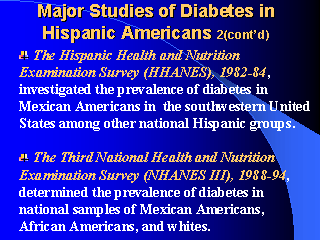|
|
|
|
front |1 |2 |3 |4 |5 |6 |7 |8 |9 |10 |11 |12 |13 |14 |15 |16 |17 |18 |19 |20 |21 |22 |23 |24 |25 |26 |27 |28 |29 |30 |31 |32 |33 |34 |review |
 |
The Hispanic Health and Nutrition Examination Survey (HHANES, 1982-84) data were
used to estimate diabetes prevalence in the American Southwest. The report
reflected age-adjusted prevalence of self-reported diabetes among
Mexican-American males, ages 20 to 74, at 6.8 percent and it was estimated to be
7.6 percent for the Mexican-American females, ages 20 to 74 years of age.
For the Third National Health and Nutrition Examination Survey (NHANES III, 1988-94) population of the same age group, however, the percentages are 2.9 and 3.8 among the males and females, respectively. The HHANES data comprises different portions of the Hispanic American and Mexican-American population residing in several Southwestern states. Thus far, the studies reviewed suggest that prevalence of diabetes is greater in Mexican-American females than in their male counterpart, greater in Hispanic Americans than in Non-Hispanic Whites, and that Hispanics usually tend to be heavier than their Non-Hispanic White Counterpart. The Hispanic population (Los Hispanos) of the state of New Mexico has a long history of residence in the region dating back to the original Spanish settlers and not surprisingly, the study found that 89 percent of the participants were New Mexico born and only two percent were Mexico born. A comparison of the diabetes rates in this sample to those reported for Mexican-Americans in Texas and the general American population revealed that the New Mexico sample had an intermediate status when compared to the other two populations. A criticism of the study arises from the use of self-reported diabetes to calculate prevalence rates in the study. The prevalence rates might have been higher if undiagnosed diabetics had been identified using other methods of diabetes assessment. In summary, the diabetic studies that have been reviewed to this point suggest that:
|